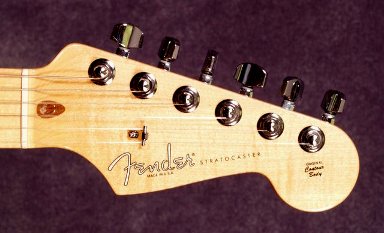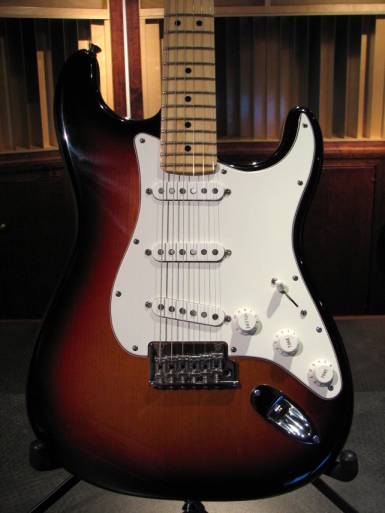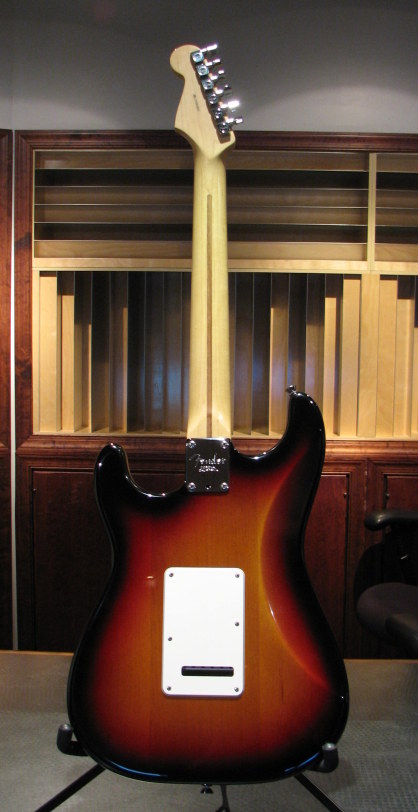The Ultimate Guitar Conformist Statment?
A Review of the 2009 Fender American Standard Stratocaster

I’m willing to admit to being a non-conformist. As a result of my proclivities, I've resisted this move for forty years. I’m hoping I can be forgiven by the rest of you, either for giving in (by some) or for holding out this long (by others). Here is the root of the problem: For years I considered the Fender Stratocaster to be the ultimate conformist statement in the guitar world. Strats are everywhere and they appear to be some sort of a default "first serious guitar" for many. And now, as all the rocksters age and their hearing and backs go, they are all falling back on the light, bright Strat. After forty years of playing, I guess it can now be said that I tried everything else first to get the Strat sound! So, I suppose it might be fair to say that this article will be an outsider's look at a modern Stratocaster. I have not, however, been unaware of the Strat through the years. I've done a lot of listening and have developed an ear for the Fender sounds I love, so perhaps it won't be a total loss. Of late, I've had to admit that more and more of my favorite guitarists used Stratocasters at least part-time and that some of my favorite sounds actually came from this guitar. Four players launched me on my odyssey looking for Strat tones: David Gilmour, Andrew Latimer of Camel, Jeff Beck, and Ted Turner of Wishbone Ash. Interestingly, all used both Fenders and Gibsons along the way and all are also melodic players who have used the Strat for "pretty" sounds that I can relate to. As I've listened, I've also noticed that many of the Strat tones I liked came from Strats with maple fingerboards.
 It has been a discontinuous odyssey: I haven’t always felt comfortable with Fender necks and especially Fender necks with maple fingerboards. Years ago when I first shopped seriously for a Strat my impressions of the then-current models weren’t very good: They sported a neck profile that was “boat” shaped, meaning that the shoulders widened out right to the edge, making them sharp and uncomfortable to me. I found lots of sharp fret ends that snapped at my fingers as well as bad fretwork that caused the strings to fret out in bends. I found cheap looking wood, poor finishing, and thin-sounding electronics that induced lots of noise. All this drove me to hold off the inevitable with the purchase of a hand-built G&L S-500 “hot Strat” with an ash body and a rosewood fingerboard. G&L was Leo Fender's last company before he passed. After working with that guitar for a while I found that there were still many classic sounds I just couldn’t get with it. Hey, is that why people have more than one Strat? So, a few years later, that, as they say, was that. I began doing my research, taking my time and doing some shopping. I’m not an impulse buyer. The point here was to find a Strat that both coughed up some of the classic tones I've loved and was comfortable to play.
It has been a discontinuous odyssey: I haven’t always felt comfortable with Fender necks and especially Fender necks with maple fingerboards. Years ago when I first shopped seriously for a Strat my impressions of the then-current models weren’t very good: They sported a neck profile that was “boat” shaped, meaning that the shoulders widened out right to the edge, making them sharp and uncomfortable to me. I found lots of sharp fret ends that snapped at my fingers as well as bad fretwork that caused the strings to fret out in bends. I found cheap looking wood, poor finishing, and thin-sounding electronics that induced lots of noise. All this drove me to hold off the inevitable with the purchase of a hand-built G&L S-500 “hot Strat” with an ash body and a rosewood fingerboard. G&L was Leo Fender's last company before he passed. After working with that guitar for a while I found that there were still many classic sounds I just couldn’t get with it. Hey, is that why people have more than one Strat? So, a few years later, that, as they say, was that. I began doing my research, taking my time and doing some shopping. I’m not an impulse buyer. The point here was to find a Strat that both coughed up some of the classic tones I've loved and was comfortable to play.
Meanwhile, I had another agenda: I wanted to find a Mexican-built Strat that was the equal of an American Strat. Yep, some of the buzz on the forums was that there really was no difference between the two other than prejudice. Great! I can put aside pre-conceived notions as well as the next guy. This was going to be a secondary guitar to me so I wanted to get into it relatively inexpensively. As might be expected in the depressed economy, I found lots of MexiStrats and few American ones hanging in the shops. And how did things turn out? It seemed as if there was a significant quality jump from the MexiStrats to the American-made ones. On the American Strats, the fit and finish, the fretwork, the set up, and the neck treatment were superior to the Mexican ones I tried. The sound was bigger, bolder, and sweeter on the American-made ones as well and they seemed to have less noise. I couldn’t find a single MexiStrat with a properly set-up tailpiece – they were all raised at the back end and out of whack. The actions and setups were universally pretty poor as well and the bodies were made from four and five chunks of wood. It was pretty depressing. I wanted to like the Mexican-built ones, but my hands, ears, and eyes told me a different story. Time to look at American Strats.
Ostensibly, the price difference between a high-end MexiStrat and an American Standard Strat is around $600, but I found a dealer who offered the American Standards for only $300 more. Once I gravitated to the American ones, my impressions of the current American Standards were much better than those from years before on my earlier shopping trips: I found the new C-shaped neck profile and the hand-rolled edges very comfortable. There was a distinct difference between the shouldering ten years ago and now. The fret work was excellent and the actions were very comfortable. The sound was spot-on with quiet electronics and full but bright, bell-like tones. The tone controls were very useable and the guitars were finished nicely. All in all, it seemed that the American Strats were great players and more aesthetically pleasing as well.

So, after shopping, playing, and auditioning for the wife, it was New Guitar Day for me! Here are the vital stats:
Fender American Standard Stratocaster, 2009
Three-tone sunburst (think Clapton’s “Brownie”) on Alder body
Thin finish undercoat to improve resonance
Maple fretboard with 22 medium-jumbo frets
Vintage style headstock and logo
Satin finish on back of neck and headstock, gloss on front
Parchment colored three-ply pickguard, knobs, and appointments
New bridge design with bent steel saddles
Copper-infused vibrato block
Delta "no-load" tone control on bridge and middle pickups
New style Fender SKB case with “ATA” latches and plenty of case candy
I chose my example by sound and feel rather than by looks and point of origin. I found one that sang without any effects or overdrive. At the store I checked it out through an amp like mine so there were no surprises when I got it home. Then I tried it out with a couple of other amps to see how it interacted with them. I went with the maple neck because of the spank it added to the sound. I chose one that had a good sound when plucked with fingers of the right hand and had a clear but sweet upper end. When I got it home and tried it through my rigs, I found it yielded both sweet clean and driven sounds as well. And how are the various sounds? The bridge position (1) is very musical and not too bright or jagged. As a Gibson-based player, I do find myself typically backing off the tone control some to end up with just the right combo of brightness and clarity. Position 2, bridge and middle, yields a lovely quack without becoming a parody of itself. With the treble backed off, I'd call it the "classic quack." Position 3 (middle pickup only) offers the classic Buddy Holly sound and interacts with a wah nicely. Position 4, neck and middle, is a bit more mellow than the neck pickup alone and has the little bit of "latex" that gives it character. And position 5, neck only, is sweet and bell-like. When playing into a rig set for humbuckers, I find myself backing off the tone control on this pickup a little bit as well. The two hum cancelling positions (2 and 5) drop the noise floor nicely but the other three positions are remarkably low in noise to begin with. When played through my trademark combination of using a rotary speaker system as one amp and H&K Rotospherein the loop of my other, the Clapton/Harrison/Lynne rotary speaker sounds just tumbled out.
Even though I've spent years on Gibsons and shorter-scale instruments, the neck is actually very natural and comfortable to me. The hand rounding of the shoulders is probably a good part of that comfort. The frets are very comfortable and to my surprise, the glossy fingerboard has ended up being a non-factor: I don't even think about it. The guitar's three-tone sunburst harkens to earlier times. As a result, the guitar is very pretty in a conservative, historic sort of way. Fifty years along, it is sometimes hard to remember that this guitar, in this paint job, was perceived as something from outer space when it first debuted in the 1950s. The big news, however, is that for a very reasonable entrance fee, I was able to find a classic sounding Fender Strat that played well, felt and looked nice, and had low-noise electronics. Any nit-picks? There are some “ping” noises from strings "griping" in the nut when the trem bar is wiggled. A little nut adjustment and/or lubrication will probably fix that.
So, once again I can say that the good guitars are out there to be found. With a little effort, you can bring home a winner… without pawning the family home. Perhaps it should also be said that if you don't like the current Strat, wait a little bit and they'll change it! Now, where are my dominoes?
Oh, and a little PSA about the spring that lives in the trem arm socket is over HERE


 It has been a discontinuous odyssey: I haven’t always felt comfortable with Fender necks and especially Fender necks with maple fingerboards. Years ago when I first shopped seriously for a Strat my impressions of the then-current models weren’t very good: They sported a neck profile that was “boat” shaped, meaning that the shoulders widened out right to the edge, making them sharp and uncomfortable to me. I found lots of sharp fret ends that snapped at my fingers as well as bad fretwork that caused the strings to fret out in bends. I found cheap looking wood, poor finishing, and thin-sounding electronics that induced lots of noise. All this drove me to hold off the inevitable with the purchase of a hand-built G&L S-500 “hot Strat” with an ash body and a rosewood fingerboard. G&L was Leo Fender's last company before he passed. After working with that guitar for a while I found that there were still many classic sounds I just couldn’t get with it. Hey, is that why people have more than one Strat? So, a few years later, that, as they say, was that. I began doing my research, taking my time and doing some shopping. I’m not an impulse buyer. The point here was to find a Strat that both coughed up some of the classic tones I've loved and was comfortable to play.
It has been a discontinuous odyssey: I haven’t always felt comfortable with Fender necks and especially Fender necks with maple fingerboards. Years ago when I first shopped seriously for a Strat my impressions of the then-current models weren’t very good: They sported a neck profile that was “boat” shaped, meaning that the shoulders widened out right to the edge, making them sharp and uncomfortable to me. I found lots of sharp fret ends that snapped at my fingers as well as bad fretwork that caused the strings to fret out in bends. I found cheap looking wood, poor finishing, and thin-sounding electronics that induced lots of noise. All this drove me to hold off the inevitable with the purchase of a hand-built G&L S-500 “hot Strat” with an ash body and a rosewood fingerboard. G&L was Leo Fender's last company before he passed. After working with that guitar for a while I found that there were still many classic sounds I just couldn’t get with it. Hey, is that why people have more than one Strat? So, a few years later, that, as they say, was that. I began doing my research, taking my time and doing some shopping. I’m not an impulse buyer. The point here was to find a Strat that both coughed up some of the classic tones I've loved and was comfortable to play.